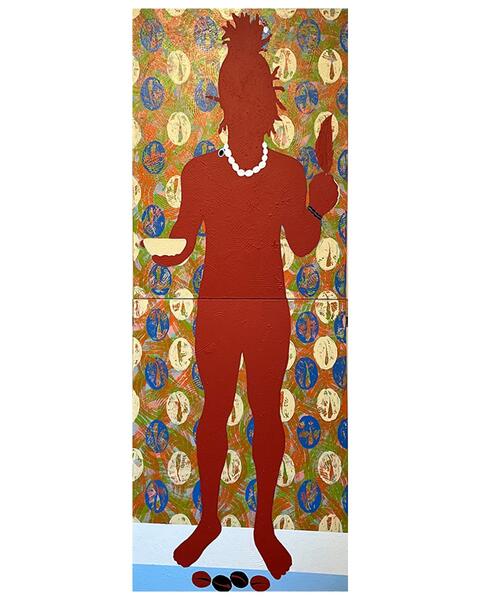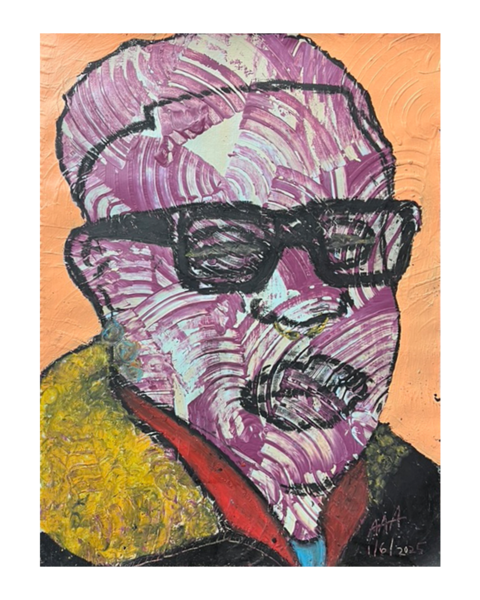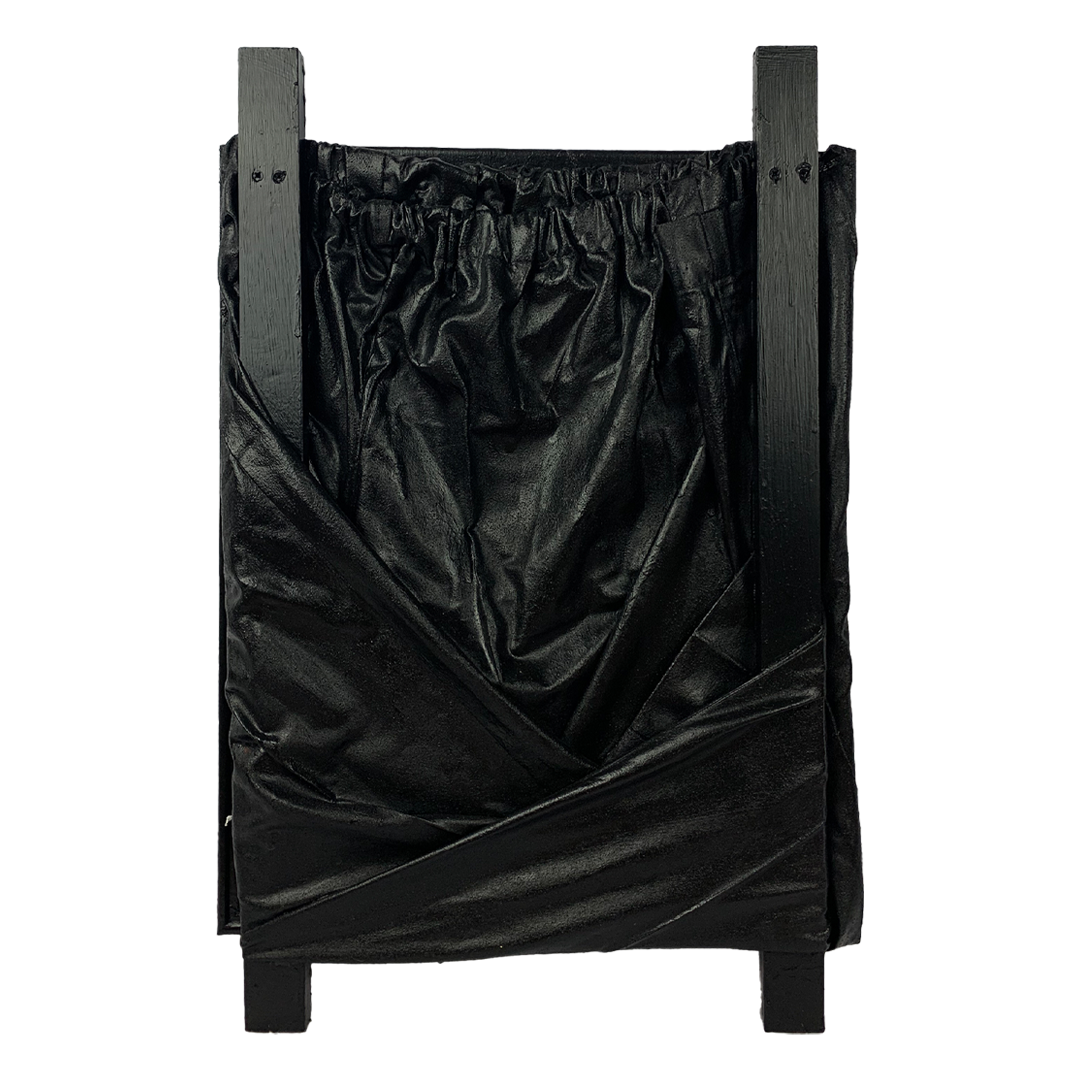Work samples
-
my body, the SEED- short film by VILLAGER
"only a fool is blinded by time to think that time only exists in the way we act upon it and with it: This is a recipe for spiritual and eternal confusion"
I often think, or rather remember, how my ancestors (me) remember time. yesterday, happening tomorrow happening today all at the same time. My grandfather once told me the past is always alive in the present- To know where you are going, you have to know where you are coming from he said. I come from a long lineage of hunters, warriors, and land stewards, a descendant of Ogun, the governor of all technologies. Our greatest technology is energy which is in constant flux and change. Time becomes the channel in which energy is revered, felt, and recorded in the annals of history. Time is the witness of all creation, the companion of all primordial beings and spirits, and the orchestrator of the divine ALL.
-
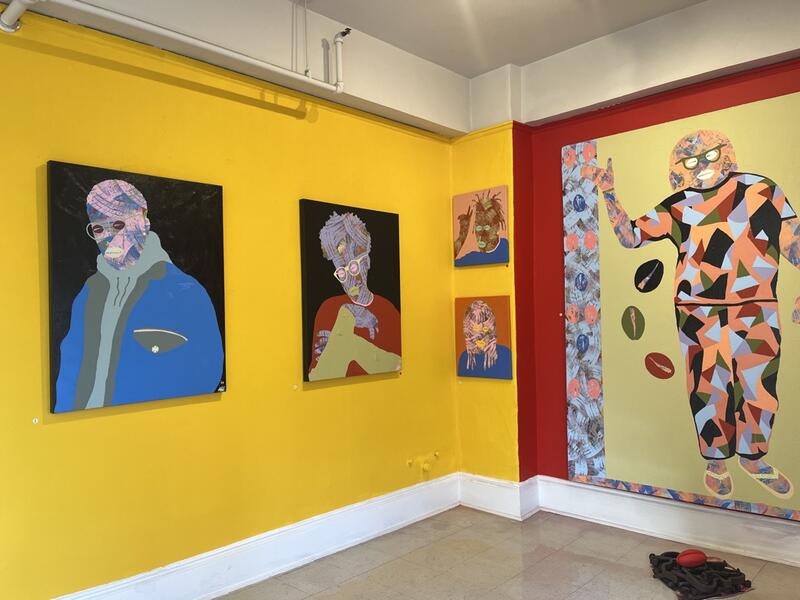 ÀṢẸ: EMBODYING THE DIVINE - solo exhibition
ÀṢẸ: EMBODYING THE DIVINE - solo exhibitionIn Flash of the Spirit, Robert Farris Thompson declares “A thing or a work of art that has ÀṢẸ transcends ordinary questions about its makeup and confinement; it is divine force incarnate”
Nigerian Born Baltimore-based Transdisciplinary Artist, VILLAGER presents ÀṢẸ: Embodying the Divine- a series of paintings, sculptures, and site-specific installations inspired by the Yorùbá philosophy of ÀṢẸ, using the polychronic concept of energy and vital life force as a cosmic declaration to embody the divine energies that catalyze our existence. Through this solo exhibition, VILLAGER invites the viewer to embark on a cosmic journey of searching, finding, and embodying - instructing us to explore our inner and outer worlds and re-imagine ourselves as sacred beings, ordained with the power (ÀṢẸ) to manifest (pà àse) and redefine our existential conditions.
ÀṢẸ: Embodying the Divine is an echo of the vitality of Yorùbá knowledge systems, practices, beliefs, and philosophies as a means for VILLAGER’s knowingness and belonging in the world - a humble reverence to their ancestral heritage, cultural expressions, beliefs, and practices. Using the energetic likeness (àwòrán) of family members, loved ones, and acquaintances, VILLAGER ritually engages their subjects in a spiritual rebirth of consciousness, transporting the subjects, the viewer, and themselves to a dynamic and holistic space where energy is experienced with an intrinsic sensitivity to color and texture.
Following in the Yorùbá tradition of wood-working, the artist uses acrylic to graft the subjects with vibrational scars of energy potential characterized by weaving-like angular patterns akin to Yorùbá weaved fabrics and Ilé-Ifẹ̀ bronze heads to reimagine and subvert traditional portraiture. The divine potential of the subjects is materially transformed and manifested through the process of scarification, mark-making, and pattern-making to enlighten their character and essential nature (ìwà). Manifested as a portal of gaze and an object of corporality, the cowrie-studded eye (òjú ìnù) is meticulously placed on the physical head (òrì òdè) in place of a physical eye to inform the inner spiritual consciousness and potency (òrì ìnù) of the subjects. This ritual of adornment also pays homage to Èṣù, the Òrìṣà of crossroads, the enforcer of all divine laws who implores us to seek balance and harmony with the ALL.
ÀṢẸ: Embodying the Divine is a reminder that we are indeed divine force incarnate. It commands us to BE divine- to embrace energy as a tangible unit of all existence and become one with the source of ALL energy. How will this surrender to the truth of divine potential empower us to evoke, transform, embrace, and embody change? In what ways will this reconfiguration manifest through our beings? How will this reconnection place us in divine harmony with our purpose of being? with our spirit, actions, community, ancestors, nature, and the divine ALL?
ÀṢẸ: Embodying the Divine was on view in the Mezzanine Gallery of the Bromo Seltzer Arts Tower from October 10 to December 17, 2024. This solo exhibition is a part of the third volume of the Emerge Baltimore exhibition series designed by Kirk Shannon-Butts, Baltimore Office of Promotion and Arts (BOPA) Senior Curator and Public Art and Curation Manager, to feature local rising artists in the historic galleries of the Bromo Seltzer Arts Tower. This project is supported in part by the Baltimore Office of Promotion and the Arts & Maryland State Arts Council.
About Abdulrasheed
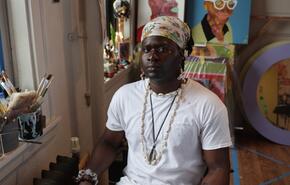
VILLAGER (b. Abdul Rasheed Adekunle Adaranijo in Lagos, Nigeria) is a Nigerian-born international Artist and Cultural Producer whose work exists to scrutinize, deconstruct, and redefine what it means to be a “Contemporary African." Through varied mediums such as painting, sculpture, print-making, photography, site-specific and public installation, audio-visual interactive media, performance art, and cultural facilitation, VILLAGER's work echoes a spiritual, anthropological, and… more
ÀṢẸ: EMBODYING THE DIVINE
In Flash of the Spirit, Robert Farris Thompson declares “A thing or a work of art that has ÀṢẸ transcends ordinary questions about its makeup and confinement; it is divine force incarnate”
Nigerian Born Baltimore-based Transdisciplinary Artist, VILLAGER presents ÀṢẸ: Embodying the Divine- a series of paintings, sculptures, and site-specific installations inspired by the Yorùbá philosophy of ÀṢẸ, using the polychronic concept of energy and vital life force as a cosmic declaration to embody the divine energies that catalyze our existence. Through this solo exhibition, VILLAGER invites the viewer to embark on a cosmic journey of searching, finding, and embodying - instructing us to explore our inner and outer worlds and re-imagine ourselves as sacred beings, ordained with the power (ÀṢẸ) to manifest (pà àse) and redefine our existential conditions.
ÀṢẸ: Embodying the Divine is an echo of the vitality of Yorùbá knowledge systems, practices, beliefs, and philosophies as a means for VILLAGER’s knowingness and belonging in the world - a humble reverence to their ancestral heritage, cultural expressions, beliefs, and practices. Using the energetic likeness (àwòrán) of family members, loved ones, and acquaintances, VILLAGER ritually engages their subjects in a spiritual rebirth of consciousness, transporting the subjects, the viewer, and themselves to a dynamic and holistic space where energy is experienced with an intrinsic sensitivity to color and texture.
Following in the Yorùbá tradition of wood-working, the artist uses acrylic to graft the subjects with vibrational scars of energy potential characterized by weaving-like angular patterns akin to Yorùbá weaved fabrics and Ilé-Ifẹ̀ bronze heads to reimagine and subvert traditional portraiture. The divine potential of the subjects is materially transformed and manifested through the process of scarification, mark-making, and pattern-making to enlighten their character and essential nature (ìwà). Manifested as a portal of gaze and an object of corporality, the cowrie-studded eye (òjú ìnù) is meticulously placed on the physical head (òrì òdè) in place of a physical eye to inform the inner spiritual consciousness and potency (òrì ìnù) of the subjects. This ritual of adornment also pays homage to Èṣù, the Òrìṣà of crossroads, the enforcer of all divine laws who implores us to seek balance and harmony with the ALL.
ÀṢẸ: Embodying the Divine is a reminder that we are indeed divine force incarnate. It commands us to BE divine- to embrace energy as a tangible unit of all existence and become one with the source of ALL energy. How will this surrender to the truth of divine potential empower us to evoke, transform, embrace, and embody change? In what ways will this reconfiguration manifest through our beings? How will this reconnection place us in divine harmony with our purpose of being? with our spirit, actions, community, ancestors, nature, and the divine ALL?
ÀṢẸ: Embodying the Divine was on view in the Mezzanine Gallery of the Bromo Seltzer Arts Tower from October 10 to December 17, 2024. This solo exhibition is a part of the third volume of the Emerge Baltimore exhibition series designed by Kirk Shannon-Butts, Baltimore Office of Promotion and Arts (BOPA) Senior Curator and Public Art and Curation Manager, to feature local rising artists in the historic galleries of the Bromo Seltzer Arts Tower. This project is supported in part by the Baltimore Office of Promotion and the Arts & Maryland State Arts Council.
-
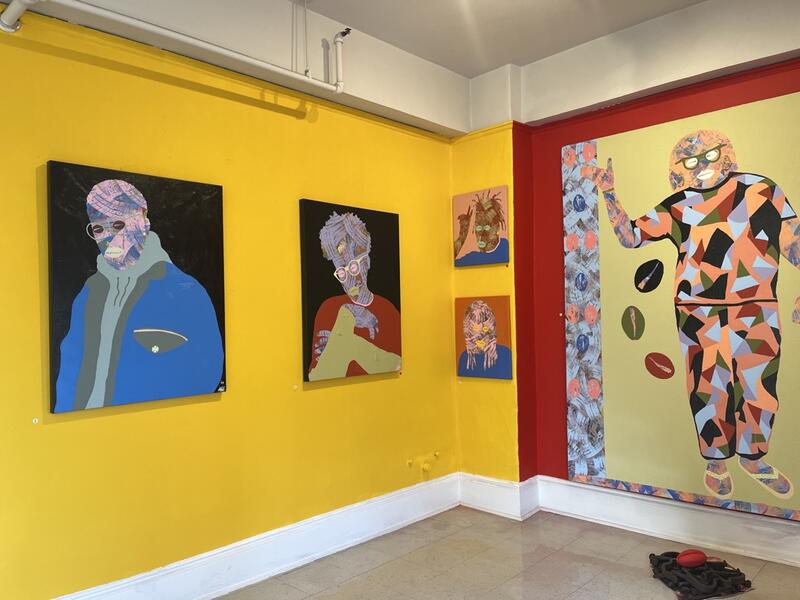 Installation view A - ÀṢẸ: EMBODYING THE DIVINE
Installation view A - ÀṢẸ: EMBODYING THE DIVINESHANE / black boy in blue under moonlight, acrylic on canvas, 40" × 30", 2024
MECCA / you are also the SOURCE of everything you exist within, acrylic on canvas, 40" x 30", 2024
spiritual ginger / VILLAGER, acrylic on canvas, 18”x 16”, 2023
JAMILAH- DAISY RETRANSFORMED, acrylic on canvas, 22” X 18”, 2023
untitled in-progress portrait of my mom, 96" x 108", 2024
-
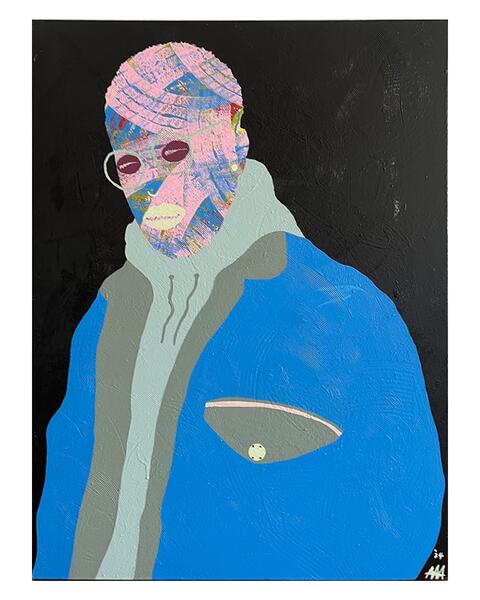 SHANE / black boy in blue under moonlight
SHANE / black boy in blue under moonlightSHANE / black boy in blue under moonlight, acrylic on canvas, 40" × 30", 2024
excerpt + additions from interview with Art Historian and Writer @angela_n_carroll Angela N. Carroll-
Angela: Tell me about Black boy in blue
VILLAGER: in moonlight black boys look blue, where they can’t be seen- is it only then that they can be vulnerable and true? thinking about black boyhood/manhood, black masculinity, and black male sexuality in parallel to the moon. thinking of the vulnerability and emotionality of this embodiment and reflecting on my life as a queer and gender non conforming person who is still doing the work to open up to the moon (and finding places and people who reflect this also)
VILLAGER: i’ve been reading and watching more literature nuancing black masculinity and black queer masculinity.
Angela: Who is it and why did you paint it? Was it inspired by the play/film moonlight by Barry Jenkins?
VILLAGER: the painting is of @thatsshanebyrd
i’m not sure if shane is queer (shane identifies as non binary and is not queer)- i was more keen on how open he moved and lived as well as the way he carried his body with grace and softness (and balance- his journey to unlearning rigid masculinity was also inspired through his lineage, his grandfather who modeled what being secure in the feminine and masculine was for him). he made me look inward and find all of the ways that i also can be soft, and feminine and still feel secure in the masculine.
Angela: I have a list of beautiful black queer films and poets and playwrights if you want it
VILLAGER: yes pls!!!!
— -
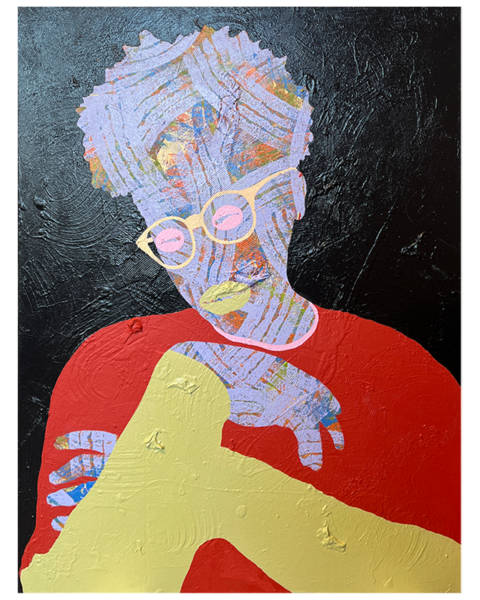 MECCA / you are also the SOURCE of everything you exist within
MECCA / you are also the SOURCE of everything you exist withinMECCA / you are also the SOURCE of everything you exist within, acrylic on canvas, 40" x 30", 2024
Using the energetic likeness and vibration of my friend MECCA @holyciudad , this work invests in the yoruba conception of ancestral communion which considers the “dead”, “living” and “unborn” as “past” “present” and “future“ which defines all energy as conceptions of non linear cyclical time and space.
“MECCA / you are also the SOURCE of everything you exist within” is an exploration of what communing and finding wholeness with our ancestors could look like and the potential of that journey to move us closer to the source- that which is WITHIN us, our MECCA.
@holyciudad ‘s life is an affirmation that everything that exists also experiences it’s own reality through us. With this work, I am inviting us all to boldly imagine what wonders await us in our lives when we begin to find safety and comfort in that power. Like MECCA, what possibilities await us when we consider how the time and space becomes contextualized and is given life through our own life’s choices and vice versa. Each motioned pattern and texture embedded in the work is unlayering the ways the past is alive in the present informing the future to determine a choice that becomes cycled as the past, present, and future again.
This work invites the viewer to contemplate on how activating and embodying ÀṢẸ can transcend time and connect us to the abundance of possibilities that exists within and around our space. How will this journey back into our agency, gracefully guide us towards our collective destinies of becoming whole?
YOU ARE ALSO THE SOURCE! -
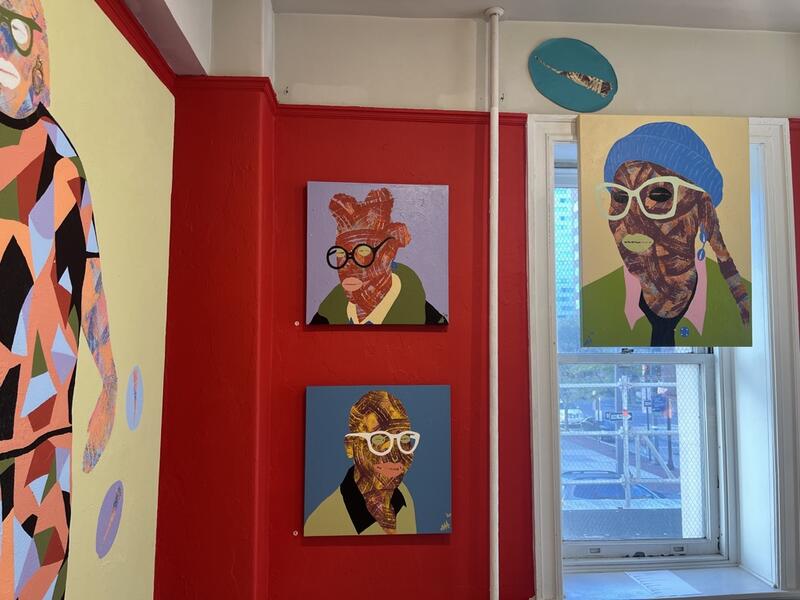 Installation view B - ÀṢẸ: EMBODYING THE DIVINE
Installation view B - ÀṢẸ: EMBODYING THE DIVINEInstallation view B - ÀṢẸ: EMBODYING THE DIVINE
rituals of knowingness and ancestral wisdom / Kehinde, acrylic on canvas, 24"x 24", 2024
steph / GOOFBALL, acrylic on canvas, 24” X 24”, 2024
DANA / vessel of (re) birthing healing, nurture, and care, acrylic on canvas, 40” x 30”, 2024
-
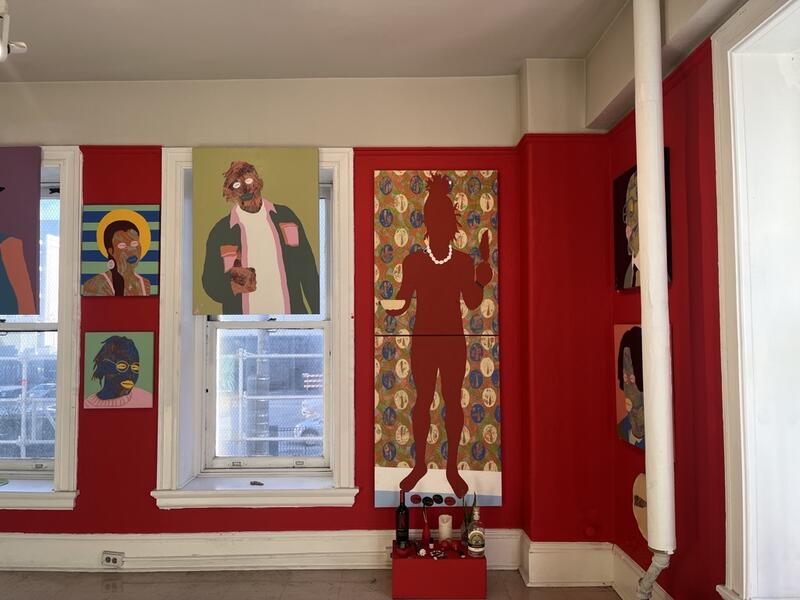 Installation view C - ÀṢẸ: EMBODYING THE DIVINE
Installation view C - ÀṢẸ: EMBODYING THE DIVINETIRZAH / the dimensionality of love, acrylic on canvas, 18”x 16”, 2023
adegebesan / i am still processing my next steps, acrylic on canvas, 18”x 16”, 2023
an ode to Black sons, brothers, uncles, and fathers / Brian, acrylic on canvas, 40" x 30", 2023
oju inu si o te alaafia wa / under the half moon, the veil is removed from the eye. I become divine harmony, acrylic on canvas, 80” × 30”, 2024
-
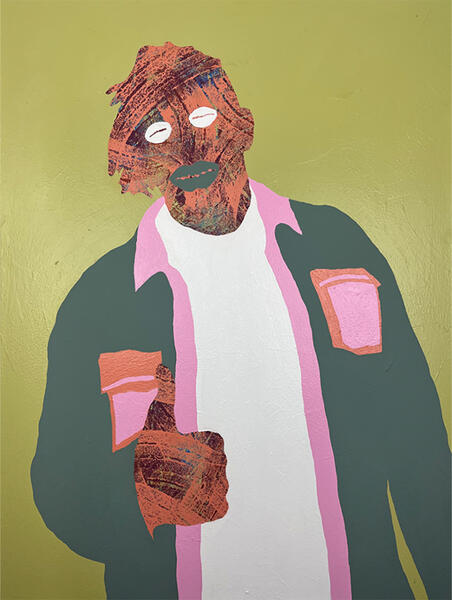 An ode to black sons, brothers, uncles, and fathers
An ode to black sons, brothers, uncles, and fathersacrylic on canvas
40” X 30” -
 ÀṢẸ: EMBODYING THE DIVINE - solo exhibition
ÀṢẸ: EMBODYING THE DIVINE - solo exhibitionIn Flash of the Spirit, Robert Farris Thompson declares “A thing or a work of art that has ÀṢẸ transcends ordinary questions about its makeup and confinement; it is divine force incarnate”
Nigerian Born Baltimore-based Transdisciplinary Artist, VILLAGER presents ÀṢẸ: Embodying the Divine- a series of paintings, sculptures, and site-specific installations inspired by the Yorùbá philosophy of ÀṢẸ, using the polychronic concept of energy and vital life force as a cosmic declaration to embody the divine energies that catalyze our existence. Through this solo exhibition, VILLAGER invites the viewer to embark on a cosmic journey of searching, finding, and embodying - instructing us to explore our inner and outer worlds and re-imagine ourselves as sacred beings, ordained with the power (ÀṢẸ) to manifest (pà àse) and redefine our existential conditions.
ÀṢẸ: Embodying the Divine is an echo of the vitality of Yorùbá knowledge systems, practices, beliefs, and philosophies as a means for VILLAGER’s knowingness and belonging in the world - a humble reverence to their ancestral heritage, cultural expressions, beliefs, and practices. Using the energetic likeness (àwòrán) of family members, loved ones, and acquaintances, VILLAGER ritually engages their subjects in a spiritual rebirth of consciousness, transporting the subjects, the viewer, and themselves to a dynamic and holistic space where energy is experienced with an intrinsic sensitivity to color and texture.
Following in the Yorùbá tradition of wood-working, the artist uses acrylic to graft the subjects with vibrational scars of energy potential characterized by weaving-like angular patterns akin to Yorùbá weaved fabrics and Ilé-Ifẹ̀ bronze heads to reimagine and subvert traditional portraiture. The divine potential of the subjects is materially transformed and manifested through the process of scarification, mark-making, and pattern-making to enlighten their character and essential nature (ìwà). Manifested as a portal of gaze and an object of corporality, the cowrie-studded eye (òjú ìnù) is meticulously placed on the physical head (òrì òdè) in place of a physical eye to inform the inner spiritual consciousness and potency (òrì ìnù) of the subjects. This ritual of adornment also pays homage to Èṣù, the Òrìṣà of crossroads, the enforcer of all divine laws who implores us to seek balance and harmony with the ALL.
ÀṢẸ: Embodying the Divine is a reminder that we are indeed divine force incarnate. It commands us to BE divine- to embrace energy as a tangible unit of all existence and become one with the source of ALL energy. How will this surrender to the truth of divine potential empower us to evoke, transform, embrace, and embody change? In what ways will this reconfiguration manifest through our beings? How will this reconnection place us in divine harmony with our purpose of being? with our spirit, actions, community, ancestors, nature, and the divine ALL?
ÀṢẸ: Embodying the Divine was on view in the Mezzanine Gallery of the Bromo Seltzer Arts Tower from October 10 to December 17, 2024. This solo exhibition is a part of the third volume of the Emerge Baltimore exhibition series designed by Kirk Shannon-Butts, Baltimore Office of Promotion and Arts (BOPA) Senior Curator and Public Art and Curation Manager, to feature local rising artists in the historic galleries of the Bromo Seltzer Arts Tower. This project is supported in part by the Baltimore Office of Promotion and the Arts & Maryland State Arts Council.
-
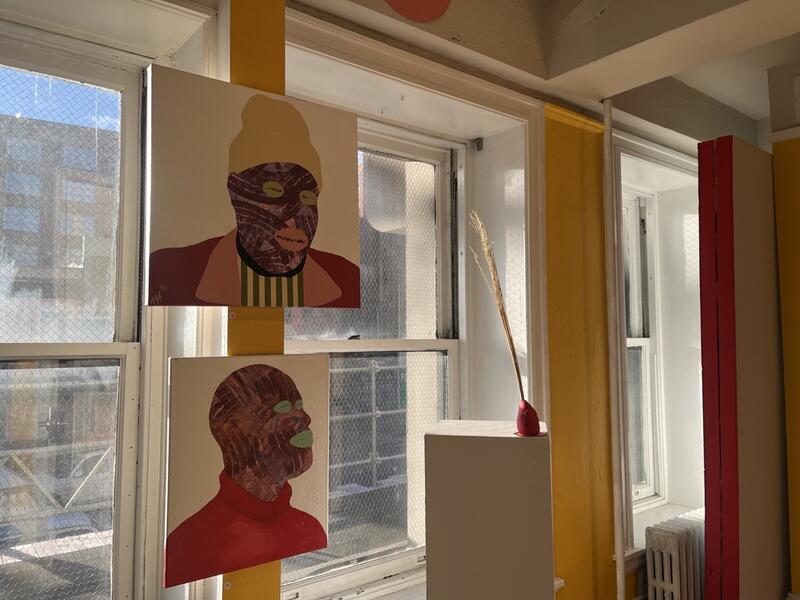 Installation view D - ÀṢẸ: EMBODYING THE DIVINE
Installation view D - ÀṢẸ: EMBODYING THE DIVINEHE WHO CAPTURES THE WORLD THROUGH THE EYES / Kelvin Bulluck, acrylic on canvas, 22” X 18”, 2023
balancing BOTH masculine and feminine energies within / ZEN, acrylic on canvas, 24'x 24", 2024
-
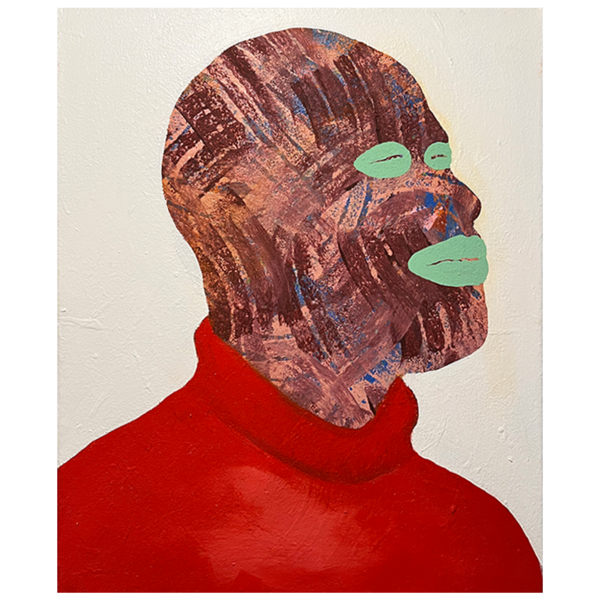 HE WHO SEES THROUGH THE EYES
HE WHO SEES THROUGH THE EYESacrylic on canvas
22” x 18” -
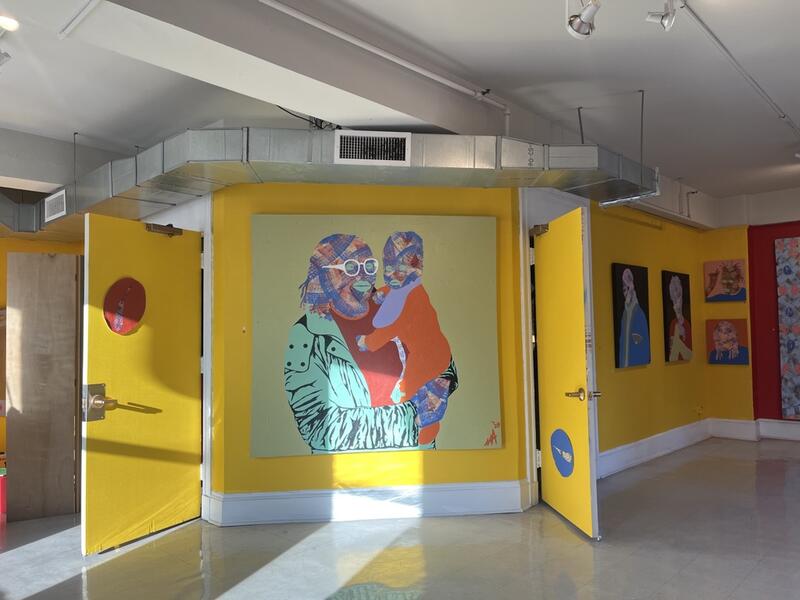 in the beginning was ASE, and that love was a beautiful rain / Zaynab and Ireayo
in the beginning was ASE, and that love was a beautiful rain / Zaynab and Ireayoin the beginning was ASE, and that love was a beautiful rain / Zaynab and Ireayo, acrylic on canvas, 72" × 58" x 2.5", 2024
This painting is the first in my Black Madonna Series- an ongoing project exploring the depths of love, connection, bond
and energy as ASE using the canonical representation of the "Madonna" in art which is a representation of Mary, either
alone or with her child Jesus, as a form to be re-contextualized and re-imagined within this scope of investigation. This
painting series was first conceptualized as an instinctive response to repairing, unlearning and relearning my relationship,
love, and connection with my mother but has quickly evolved into a novel form of documenting, celebrating, revering, and
honoring black motherhood.
IRIN AJO
IRIN AJO: A journey back to the way, to consciousness, to HOME
---
what is home? aren’t we all looking to find home? to wake up from our sleepwalk and align with our true purpose? what is your relationship with your star? your spirit? your self? what are the lessons to be learnt? histories to be remembered? stories that must be told? how many lifetimes can one live in one lifetime? which melodies must be created? what are possibilities to be discovered? which lives must be redeemed amongst them? which timelines must be erased to begin anew? what love must be conjured and incarnated, kept whole and regenerated everyday of our lives as we find our way to HOME?
which gospels must be preached? what mysteries must unfold? what realities need to be imagined? what actions will produce which consequences? what lessons must be learnt? what life does that create? what light are you walking in?
the future speaks through us in all things that are here so through this work I am asking- who are you? what do you come from? why are you here? what are you here to do? where are you going?
---
-
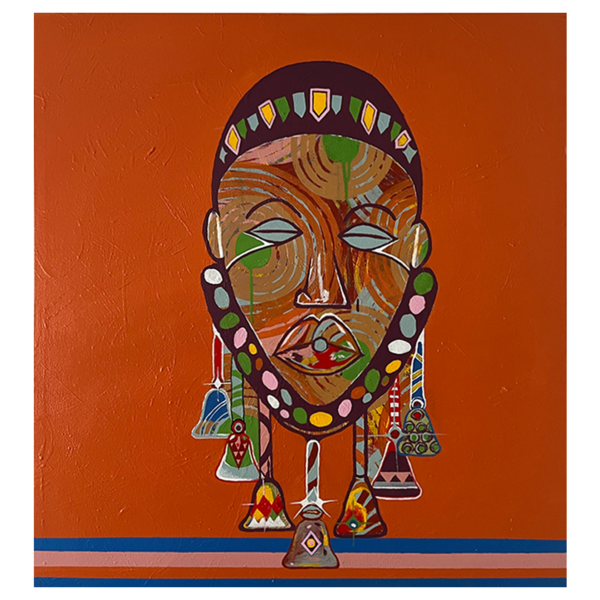 ÀSE
ÀSEÀSE, 2023
acrvic on canvas
36" × 36" -
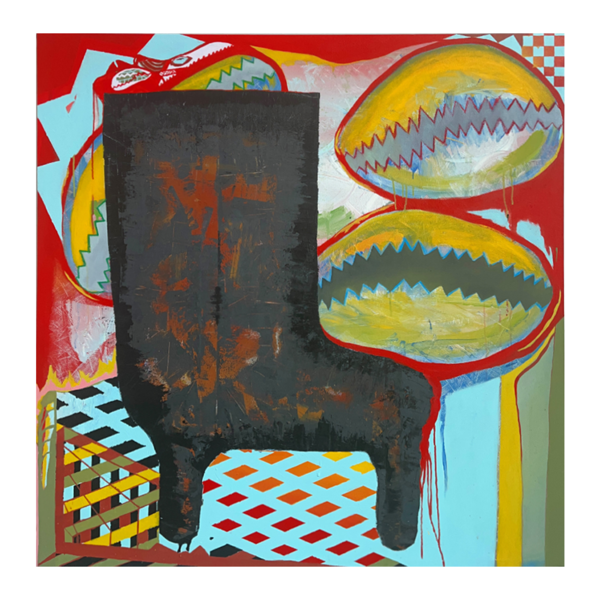 seated/seeded
seated/seededseated/seeded, 2023
mixed media on canvas
48" × 48"“for I have set a table before you in the presence of abundance, plant your dreams and desires for their roots shall germinate”
this work carries a lot of desire, planted in intention and transported using elements of cultural significance and power-
i created this work in response to a recent group show titled “we create by being” when I started asking questions- what does it mean to be? what do i desire to be? desire for my being? what do i desire for my people? What do we claim as power?
I wanted to create a piece that felt extremely rooted, unmovable, protected, and nurtured like the nyanwezi throne chair from the nyanwezi region of Tanzania which I took inspiration. The chairs were used by chiefs during judgments and initiations-. like that chair, this work is an expression of all my desires of being, to be seated and positioned in the limitless abundance that is inherent to my being, and the protection and nurture that is native to my existence.
finding rooting in these mantras also means holding and extending these thoughts for my people, for ALL black people, in all our multiplicity of being. although cowries may be mostly known for their monetary value, In a social landscape that is ever-changing, I wish for these cowries to grant us all passage into a space where comfort, leisure, hope, protection, prosperity, peace, love, and abundance is possible and present. this work aims to create such uninhibited space and a sense of ownership over said space where we can flourish in existence. A space where possibilities are endless and limitless for Black folks everywhere. A space where freedom is imaginable and real.
This work continues to hold, grow and multiply these intentions abundantly for myself, my friends, my family, and for my people, inviting the viewer to seek, enter and own these spaces with freedom.
Ase! Ase! Ase!
-
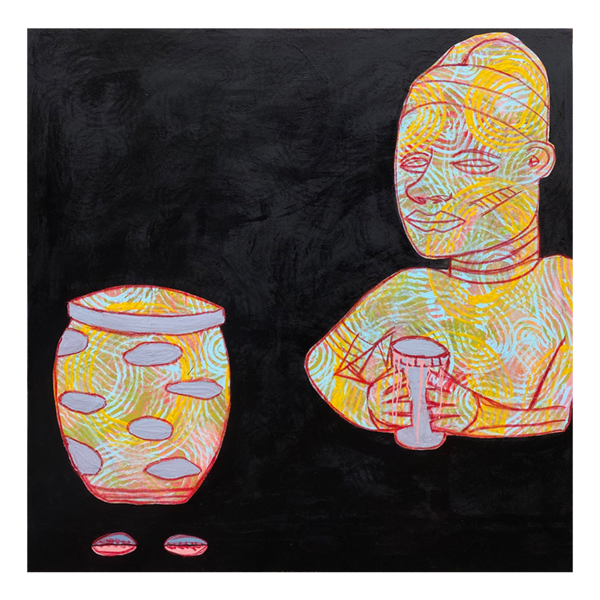 a dupe fun ore oni / gratitude
a dupe fun ore oni / gratitudea dupe fun ore oni / gratitude, 2023
mixed media on canvas
48” x 48”
eni t'oba dupe ore ana, a ri emii gba // If you give thanks today, you will live to receive another one tomorrow.
I've found that gratitude is the key to being in the present- in the NOW. it grounds and affixes you to reality and brings your journey into perspective.
so give thanks today!
and rejoice for the journey of life itself!
GODSPEED
---
I will also like to share an affirmation that I repeated continuously as I worked on this painting and invite you to join me in multiplying the intention of gratitude by reading the following affirmations out loud to yourself-
a dupe fun ore oni / I give thanks for today’s blessings
a dupe fun ore ana / I give thanks for yesterday’s blessings
a dupe fun ore ola / I give thanks for tomorrow’s blessings that is yet to come
-
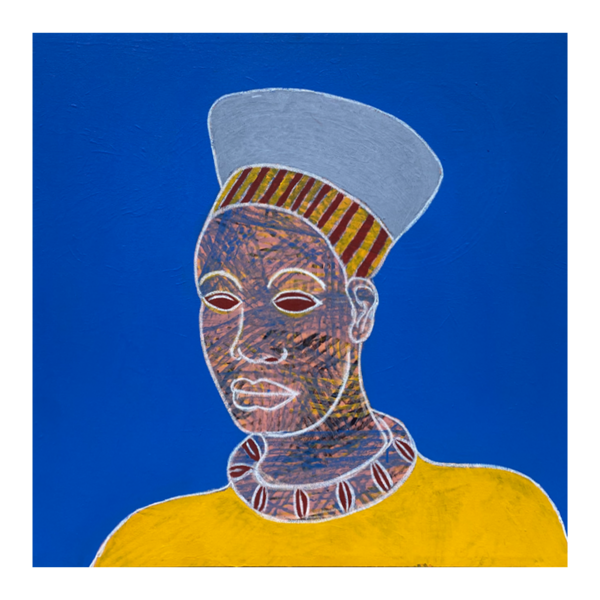 ranti omo eni ti iwo nje / remember those lives are connected to yours
ranti omo eni ti iwo nje / remember those lives are connected to yoursranti omo eni ti iwo nje / remember those lives are connected to yours, 2023
mixed media on canvas
36" × 36" -
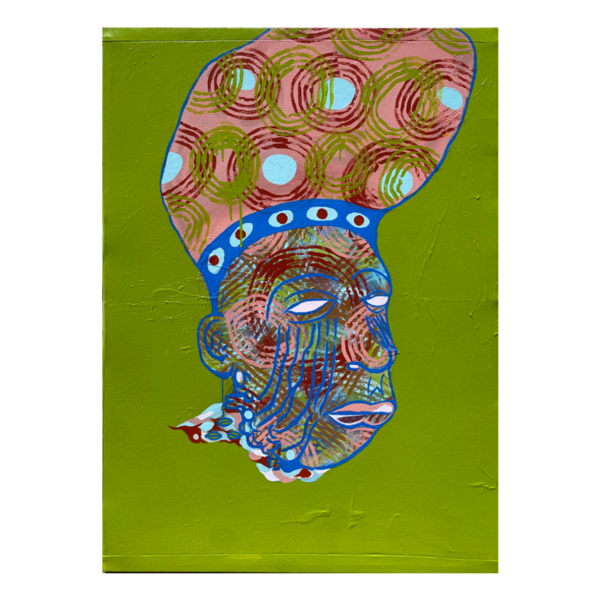 eru ti a gbe si ori / the weight we bear
eru ti a gbe si ori / the weight we beareru ti a gbe si ori / the weight we bear, 2023
acrylic and soft pastel on canvas
48" x 36" -
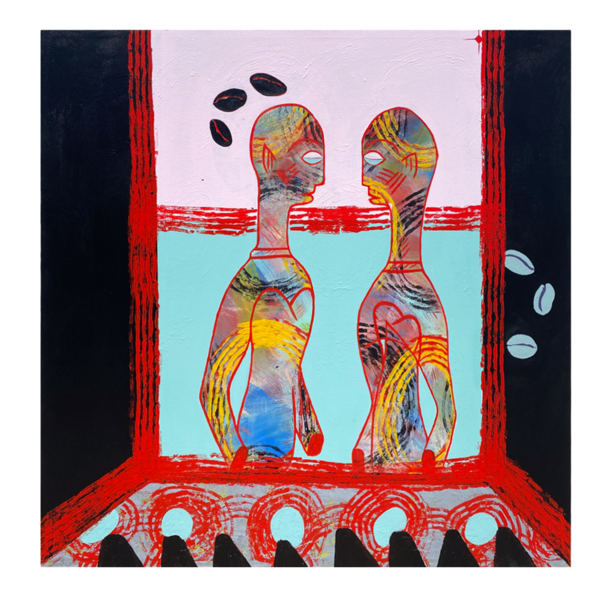 nkan ti oju ri enu a fi pamo / what the eyes see, the mouth holds in secrecy
nkan ti oju ri enu a fi pamo / what the eyes see, the mouth holds in secrecynkan ti oju ri enu a fi pamo / what the eyes see, the mouth holds in secrecy, 2023
mixed media on canvas
48" × 48"forging a new pact with one’s spirit, an opportunity to master one’s self.
-
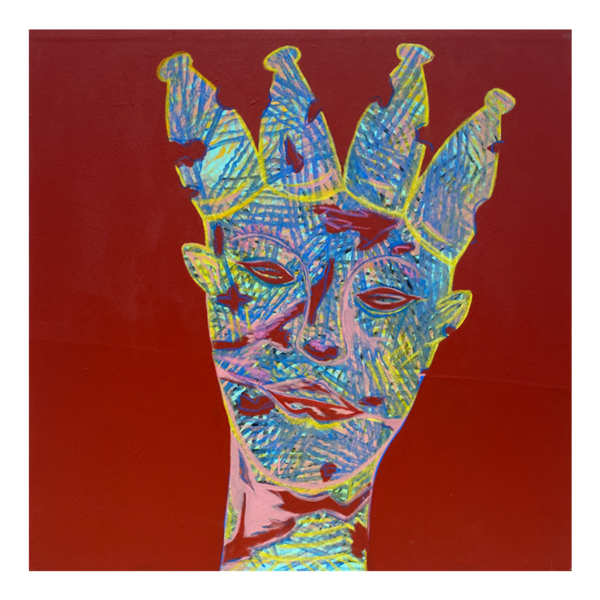 OGUNWEMIMO
OGUNWEMIMOOGUNWEMIMO, 2023
acrylic, soft and oil pastel on canvas
36" × 36" -
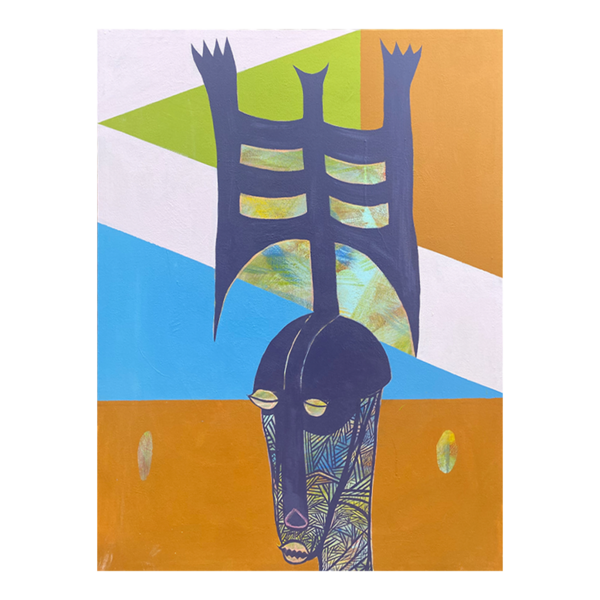 ifokonbale / sea of serenity
ifokonbale / sea of serenityifokonbale / sea of serenity, 2023
acrylic and oil pastel on canvas
48" × 36" -
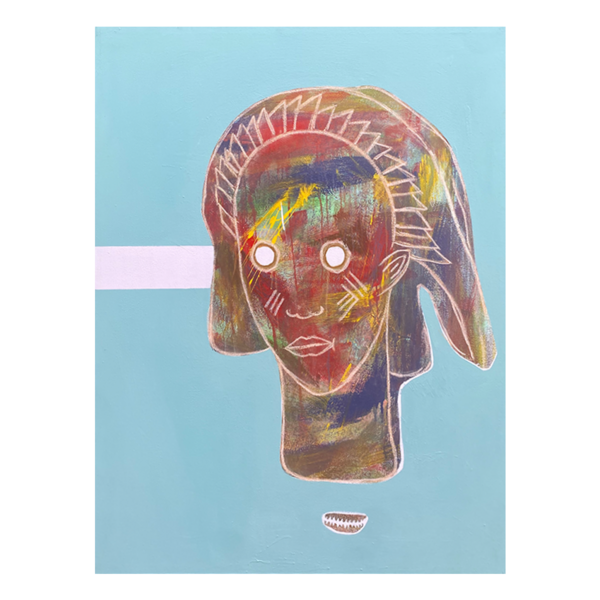 FOJUKANMI / GAZE
FOJUKANMI / GAZEFOJUKANMI / GAZE, 2023
acrylic, soft and oil pastel on canvas
48" × 36" -
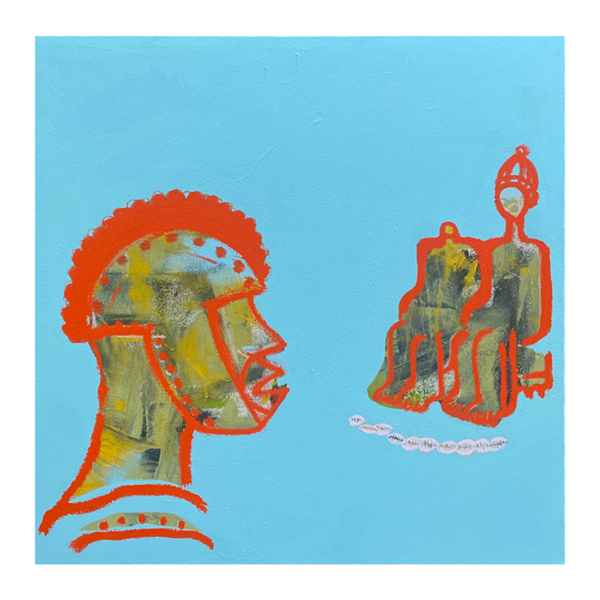 ife bi eji owuro / love like the morning dew
ife bi eji owuro / love like the morning dewife bi eji owuro / love like the morning dew, 2023
acrylic and oil stick on canvas
30" × 30"
PORTAL SERIES
To understand ourselves and our history means to reflect on time, and to understand time, we need to reflect on ourselves and the histories that transported us here- to this exact moment. The portal series is a journey to finding possibility, and newness through the imagination of a vast world waiting to be occupied. It is an embodiment of our histories, our memories, our nostalgia, and our desires.
When I started the portal series, I was thinking about the ways culture influences our ideas of the rhythms and cyclicalities of our existence and the ways we experience phenomena in the physical and non-physical world through time and space. Inspired by the Yoruba non-linear understanding of life and death, this body of work explores the experience of temporal structures like entrances and exits and the way they define our experience of being in the world. The circular forms that dominate are imprints of portals and traces of memories manifested as temporal structures or windows into different worlds symbiotically interacting with our sense of beginnings and endings.
Each painting is individually inscribed with a stylized cowrie that is embedded amongst a neural network of materially interwoven and temporally linked portals, as a measure of intervention of time, generating the space to affix oneself to a certain reality or transport to another. The portal series is a practice of time bending, transporting, and transmitting matter, space, and time, asking us to re-examine our understanding of the time-space continuum, granting the present passage to the past and offering unique and boundless opportunities to the future.
The work seeks to reshift and reexamine how our understanding of time dictates our experience of being. How will the way we understand time reflect in the ways we see ourselves? How can we travel through time to recover the memories of our ancestors which shape the past, present, and future? and how will this ritual of remberance itself remember the present which is us/we?
-
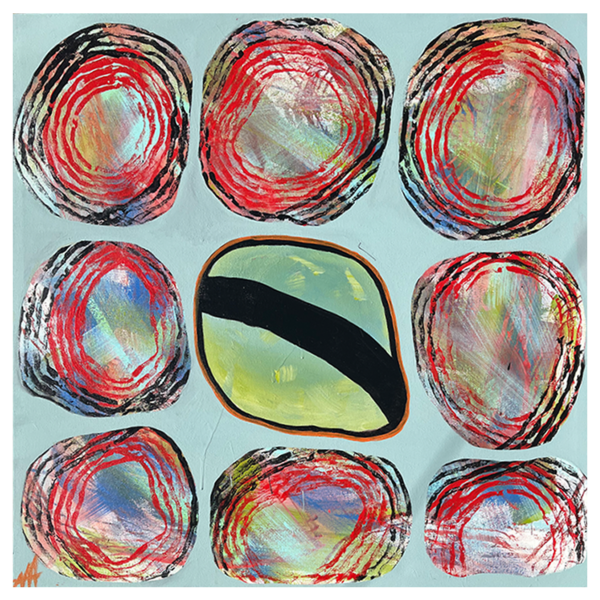 IBERE ATI OPIN / In the beginning was the end, and the end was the beginning
IBERE ATI OPIN / In the beginning was the end, and the end was the beginningIBERE ATI OPIN / In the beginning was the end, and the end was the beginning , 2023
acrylic on canvas
36" × 36"
in the beginning was a portal
it shone with the marks of time
and sizzled with the undiminshable fury of the sun itself.
and the space through it led to darkness
and olodumare said let there be light
and the birds, confused in the chaos of a new destiny
furious-
scattered there sands of the beach that they laid therein
on to the eyes of the sun.
the sun cried in agony, every drop coagulating and multiplying and shifting- rapidly
through, around, away and from the sands
and so life was created.
and thereafter the sun vowed to always remind
punish the people of the land of the fury that had begotten it a million years ago.
so another canon is rewritten and history hurries along”. -
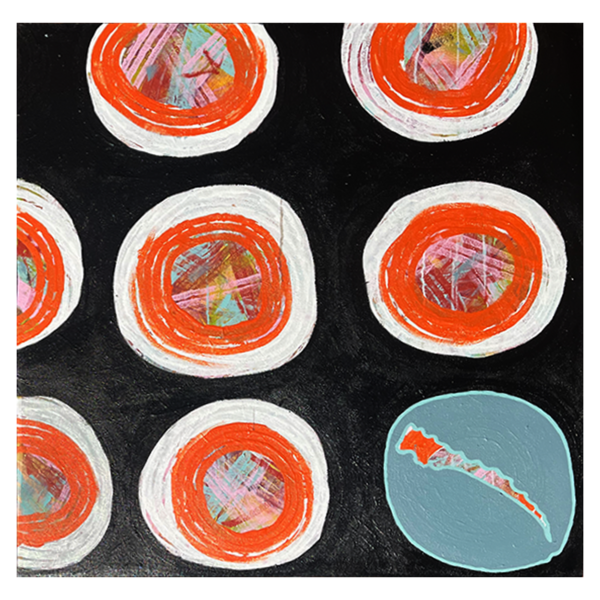 amo ara wa / i belong, you belong, we belong
amo ara wa / i belong, you belong, we belongamo ara wa / i belong, you belong, we belong, 2023
acrvic on canvas
36" × 36"as an artist, your life and your experience is always worthy of story telling! it’s always worthy of translation into inspiration for or behind your work. sometimes, you have to let your work sit and listen to it as it informs itself and as your life informs the work.
beauty is illumination. black is that, rich beauty. to be seen is to be celebrated, that’s the takeaway. -
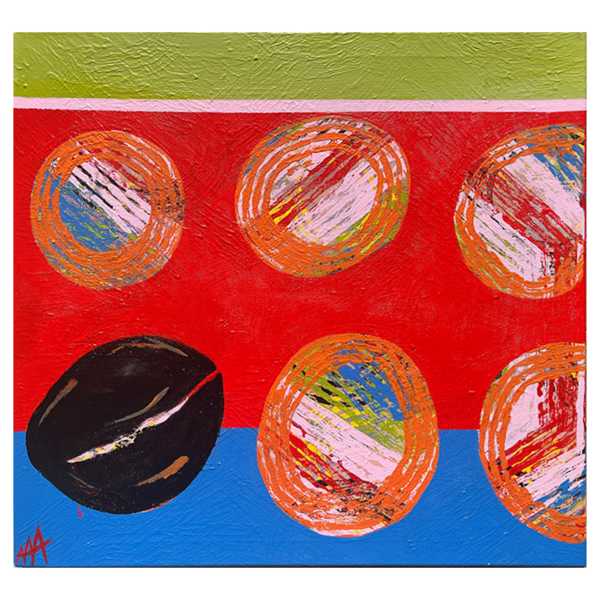 a cross examination of any oppressed (mind/body/land) under (neo) colonial rule
a cross examination of any oppressed (mind/body/land) under (neo) colonial rulea cross examination of any oppressed (mind/body/land) under (neo) colonial rule, 2023
acrylic on canvas
30" × 30"an abstract cross examination of any oppressed (mind/body/land) under (neo) colonial rule
-
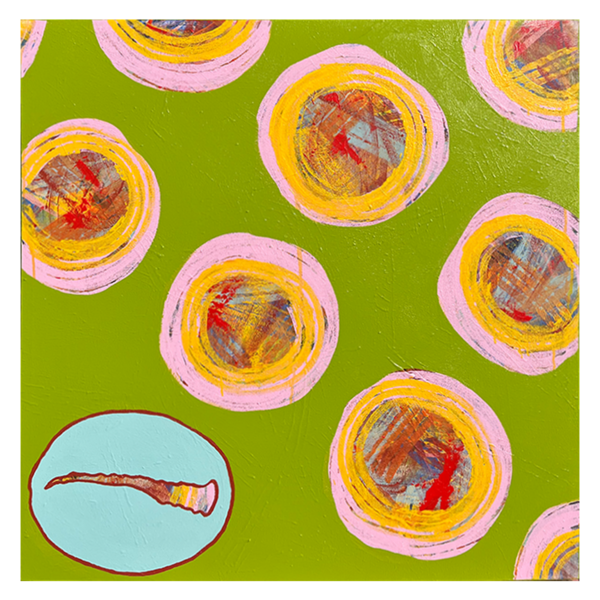 oju inu ni a fi ko ile aye / keep re-dreaming the world with more light
oju inu ni a fi ko ile aye / keep re-dreaming the world with more lightoju inu ni a fi ko ile aye / keep re-dreaming the world with more light, 2023
acrvic on canvas
36" × 36"it is our duty to keep re-dreaming the world with more light, with more compassion, with more love
-
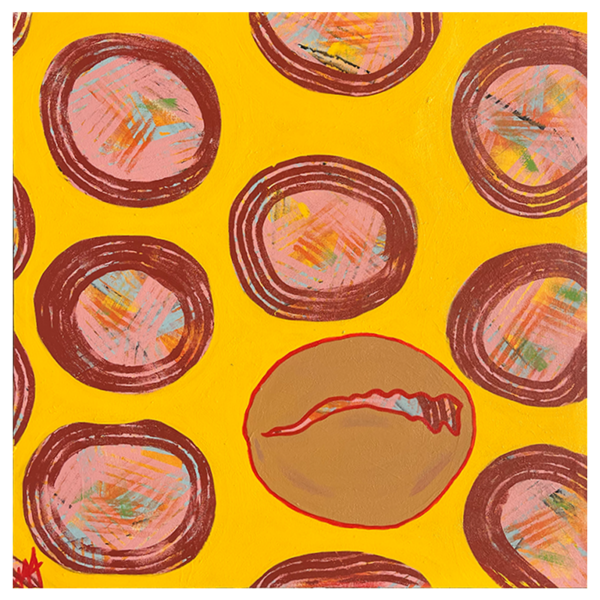 fi ibanuje se erin / from grief to happiness?
fi ibanuje se erin / from grief to happiness?fi ibanuje se erin / from grief to happiness?, 2023
acrvic on canvas
36" × 36"This work "fi ibanuje se erin" is an expression that I have approximated and decontextualized to mean ‘turn grief into happiness” in English- What does it mean to lose? What are the ebb and flow of emotions that come with grief? How does one accept the loss of someone close to them? What does healing look like? How does one get to happiness? Can you get to happiness? These were the initial questions I had when It came to developing this work.
“fi ibanuje se erin / from grief to happiness” is a profound exploration of grief and loss, inspired by the personal experiences of those within my community and the universal, collective human condition. I was also thinking about how grief and loss continues to affect those around me- especially in the last month, baltimore has felt loss deeply. I have watched some of the folks that I know, truly experience loss of their loved ones, sister, aunt, friend, uncle etc and this work is really about the important and underlying need for action, for care, for nurture during these times.
What does freedom look like? How can acceptance, resilience, and the gradual mending of the emotional, spritual and physical self happen within ourselves? within the community? In spaces where we can physically reach and in spaces where we cannot. How can we begin to foster, propagate, and propel healing for one another? Can we ever get to healing? will it be possible to ever get to happiness?
These are the questions that I engage with in this work. For me, I do not have all the answers but I do know that grief connects us all. Grief is not merely an emotional response to loss but rather a powerful revelation of our own mortality. When we grieve, we confront the unassailable truth that life, with all its beauty and complexity, is transient.
IPADAWA: The journey of a wounded healer
“IPADAWA: The journey of a wounded healer” in my ongoing visual series of portraiture work which explores the corporeal embodiment of the divine essence/life force that sustains all existence and the journey back into reconnection with that power through the body.
These daily self-portrait collage drawings are journal recordings in response to my journey back into awareness in my body as a vessel transmuting trauma into healing. Grounded in explorations of my personal identity and cultural experiences, “IPADAWA” ritually mobilizes my personal experiences and mythologies, the compositional strategies of visual artists like Devan Shimoyama, Amako Boafo and Andy Warhol, fused with symbolisms of Yorùbá spiritual practices and cultural traditions into the canon of portraiture by reexamining the intricacies of spiritual, physical, and emotional intimacy within the body.
Using photographic self-documentation as the source of this work, this practice of portraiture serves as mirrors for personal introspection, windows of appreciation of the beauty in the mundane, inviting the viewers to journey through a portal space of awareness in our bodies as the technological site of experience, empowerment, resilience, and transformation- The vessel that beholds holds their healing potential.
-
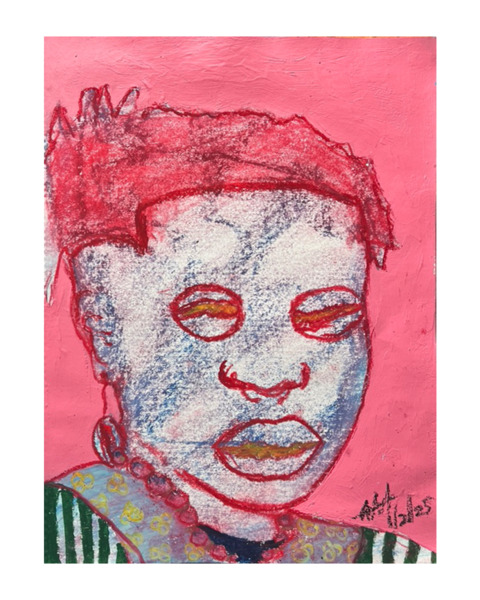 untitled 1
untitled 1acrylic and oil pastel on mixed media paper
9 in x 12 in
2025
-
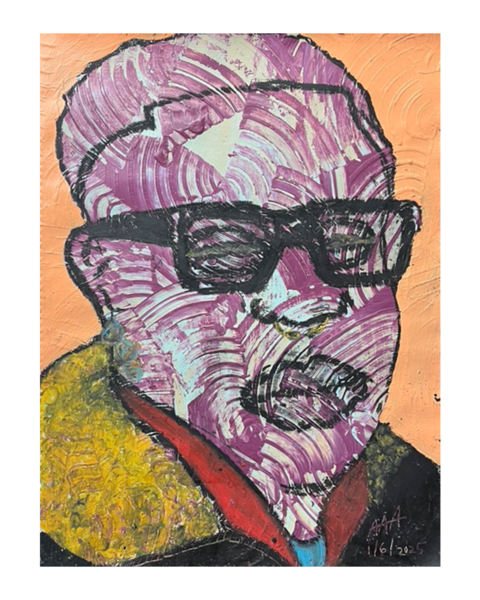 untitled 2
untitled 2acrylic, graphite, and oil pastel on mixed media paper
9 in x 12 in
2025
-
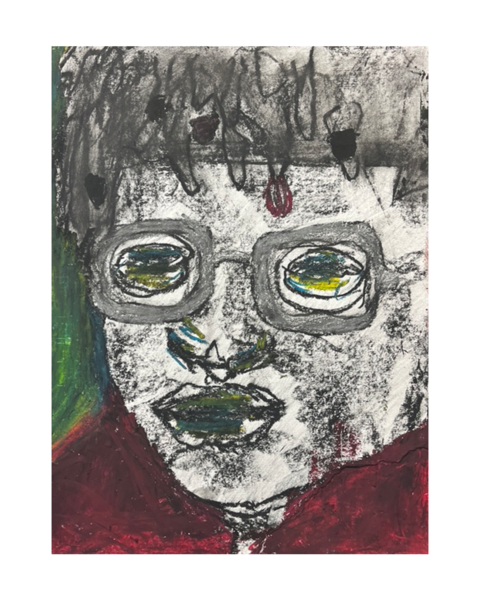 untitled 3
untitled 3mixed media collage on mixed media paper
9 in x 12 in
2024
-
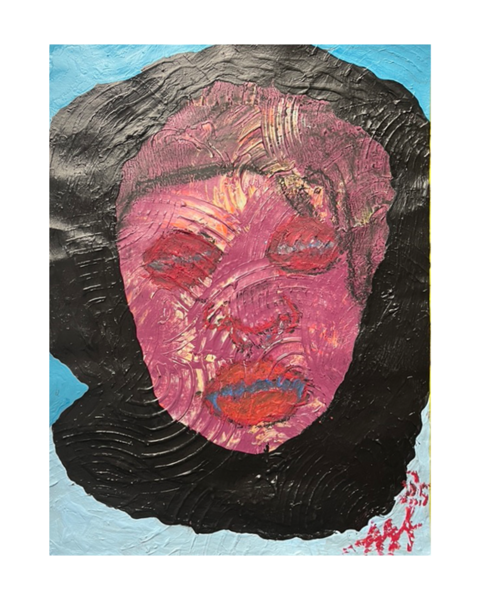 untitled 4
untitled 4acrylic graphite, and oil pastel on mixed media paper
9 in x 12 in
2025
-
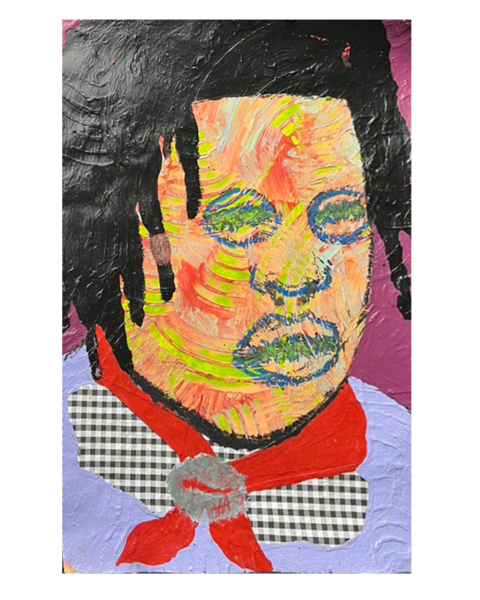 untitled 5
untitled 5mixed media collage on mixed media paper
9 in x 12 in
2025
-
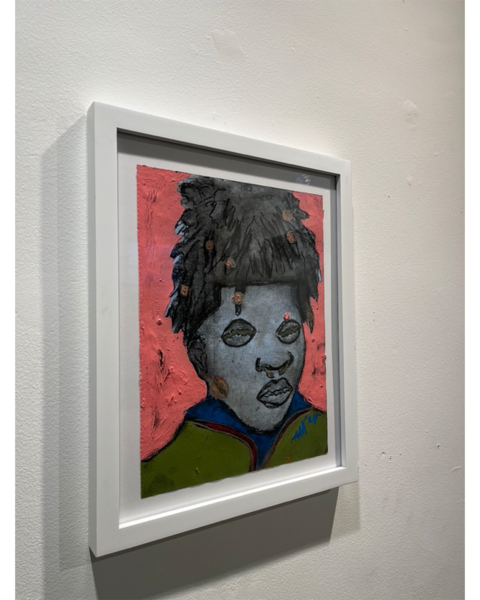 untitled 6
untitled 6acrylic, charcoal and oil pastel on mixed media paper
9 in x 12 in
2024
WITH MY BEING
WITH MY BEING, is a series of soft sculptures that temporally and spatially investigates the impact of culture on the formation of identity. This project was birthed as a reclamation, recontextualization, and reimagination of my culture and origin in a way that is true to me. This body of work is a reconstruction of the traditional, reimagining the past into the present by energetically transforming cultural objects into modern emblems of significance. Each of the sculptures in WITH MY BEING is inspired by and utilizes the agbada, a four-piece yoruba traditional suit traditional, metaphorically and physically representing varied aspects of an evolving understanding of culture as it relates to tradition, home/place, self(identity), gender, sexuality, religion/belief practice, language and knowledge systems & production, and mortality. The agbada consists of an awosoke (a large, free-flowing outer robe), an awotele (undervest), a sokoto (pair of trousers), and a fila (hat).
Using angular folds and conscious manipulations, the sculptures in WITH MY BEING receive their main form from the fabric material of the individual pieces of the agbada. The fluidity of the fabric is activated using acrylics, each fold reflecting the intimate conversations between all versions of myself echo through time, as well as a parallel representation of the evolutionary relationship between the materials with time. The sculptures serve as both the object result of the re-imagination of culture, as well as the imbued essence of that process of evolution. Through this body of work, I aim to give voice to my experiences and celebrate the intangible influence of culture on our perceptions of self. Using wood as a medium of transformation, the wooden appendages/constructions represent the reimagination of the material object from processed back to natural, physically projecting life onto the body. The precise angular movements and formations of the pressure-treated wood constructed upon the fabrics mirror a similar evolution of self, mirroring the unending process of unlearning, learning, and (re)actualization of self.
WITH MY BEING is a modern interpretation of the traditional, recontextualizing rich cultural material and energetically abundant objects into emblems of remembrance, joy, autonomy, pleasure, freedom, and knowledge in a neo-colonial landscape. Re-understanding culture through evolutionary transformation this work invites the viewer to reflect on how culture can both shape and limit our perceptions of SELF in relation to identity, autonomy, and freedom.
-
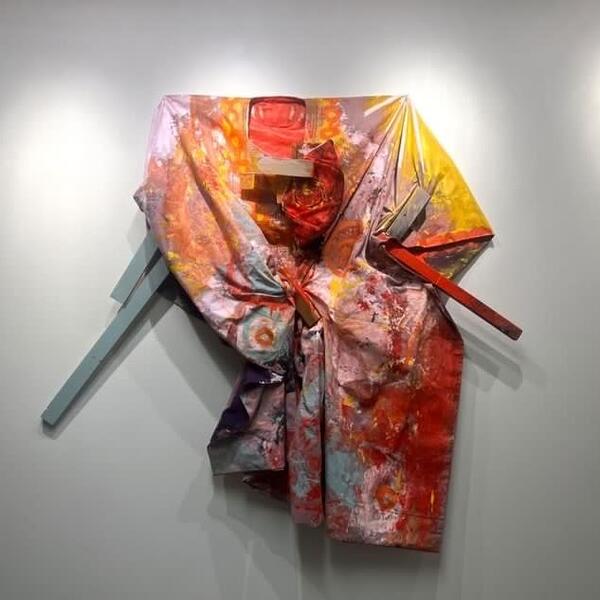 a jarring jubilee, 2022 Acrylic and pressure treated lumber on Awosoke
a jarring jubilee, 2022 Acrylic and pressure treated lumber on Awosokea jarring jubilee, 2022
Acrylic and pressure treated lumber on Awosoke
36" x 42"
-
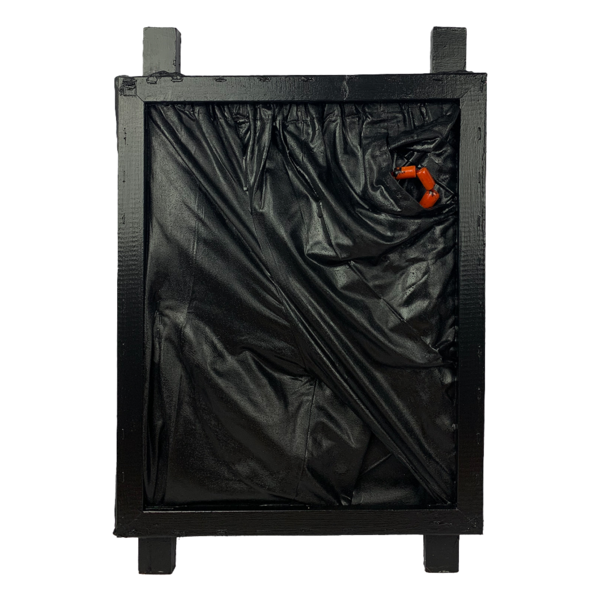 l'abe pata
l'abe patal'abe pata, 2022
acrylic, pressure-treated lumber, african coral beads, and canvas frame on sokoto
26" x 18"
front view
l'abe pata uses the sokoto to explore and re-understand the sexual politics of the body with respect to autonomy and freedom, examining the Yoruba culture and the bordered region called Nigeria today, as a product of colonial imagination. The sokoto are made of different length and shape but generally resembles a pair of trousers and are held around the waist by a fabric cord. Using wood as a transformative medium, this sculpture illuminates this process of “determining who is more human” encouraged by the existence of laws like the “Same-Sex Marriage Prohibition Act,” (SSMPA)* in Nigeria and other similar inhuman laws throughout the world, to produce a binary definition of humanity and further compound on the OTHER-ification of minority bodies and voices- in this case, enforcing heteronormativity and the gender-sex binary.
The visual imagery embedded in the front view of this sculpture is specifically targeted at this law- as a remembrance of the inhumanity suffered by those affected. The front view conveys this feeling of being “different” and the social recognition of inhumanity attached to the queerness that was imposed upon Nigerians in 2014. As the coral beads stand out in the sea of black, also is the condemnation and monopolization of queer bodies loudly illuminated. This sculpture addresses the social culture of homophobia, patriarchal masculinity, and body policing that currently exists in Nigeria. The “african” coral beads also metaphorically represent the adoption and then essentialization of western ideations of gender into the Yoruba culture and broader Nigeria, while similarly personifying the physical adoption of the Sardinian coral gem jewelry acquired through trade, to a level of secular permanence often mistaken with indegenity.
l'abe pata recontextualizes the concept of sexual expression in Nigeria that is rooted in this Western ideology of Scientia Sexualis by focusing mainly on the crotch-groin region of the sokoto. The framing also centers the gaze in a way that is reminiscent of the obsession with the sexual anatomy and its utility that is innate in Western idealism, a condemnation of the speculative narratives surrounding queer bodies. The overwhelming black pigment references the social and cultural hegemony of Western culture that seeks to define absolute good and absolute evil thereby generating binary oppositions like white/black, savior/savage, primitive/colonized, and normal/taboo. This framing intentionally parallels the obsession with the body - both what is seen and unseen. This constant deliberation is truly a measure of humanity- to determine who is more human and who is less human.
Therefore, this piece channels a physical space for re-understanding and re-evaluating how we view the body. How is the body policed? When obligatorily confessing the truth of sex/sexual anatomy/sexual orientation becomes the norm, then what are the implications in relation to our understanding and practice of autonomy and freedom? How does that translate to our deliberation/understanding of humanity?
-
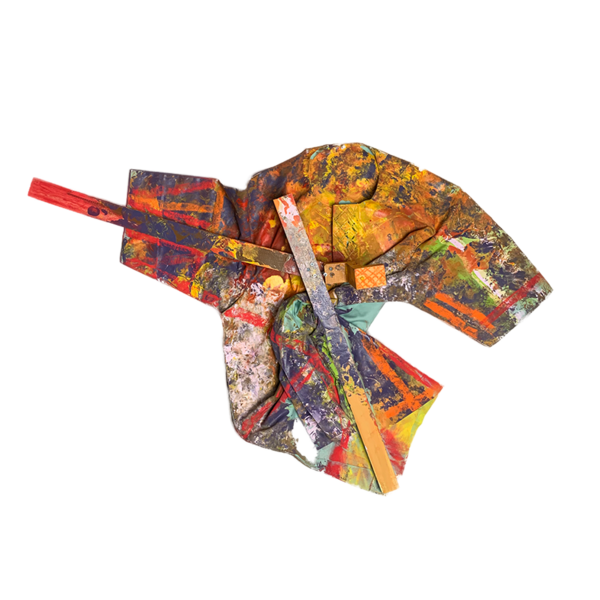 mo japa
mo japamo japa! , 2022
acrylic, pressure treated lumber, and soft pastel on Awotele
41 “ x 38 3/4 ”
mo japa! meaning "I escaped" in yoruba represents my journey of repositioning myself within my body explored using the awotele, a loose round neck shirt usually fabricated with either long or short sleeves, as a vehicle of exploration and reconfiguration.
This sculpture serves as a metaphorical mirror of the (my) human body outside of its physical unit. Intentionally manipulating the form of the awotele using acrylics and wood, this sculpture explores the relationship between both materials to birth the relationship between the physical and social body. mo japa! is an expression of my understanding of how physical bodies inform social order and vice versa. The arrangements of lumber-treated wood leaping out of the chest region of the awotele signal the formation of the body (physical) as well as the continuous reconfiguration of the body (physical and social) through social experience. This evolution is projected in the wooden appendage-like form essentialized by the red and orange triangular impression on the awotele arm in a neuron-like formation that receives stimulus from both its internal environment and external environment. The red pastel lines extend and mimic the vascular system, representing the very life force that binds us to this social and physical experience
As such, this sculpture is a production of a body form- an unfinished (EXTRATERRESTRIAL) vessel that can be dynamically inhabited to inform one’s sense of self in one's body and external environment. Considering the idea that the body will always be on view and within view in the social landscape, mo japa! reflects a cumulative repositioning of autonomy and freedom within my body, reclaiming and re-envisioning my physical body as an unfinished vessel for reformation, healing, learning, and existence- that which I have oriented and situated myself within
-
 l'abe pata (rear view)
l'abe pata (rear view)l'abe pata, 2022
acrylic, pressure-treated lumber, african coral beads, and canvas frame on sokoto
26" x 18"
rear view
The rear view of l'abe pata ( meaning under the underwear) uses the sokoto to echo Yoruba traditional knowledge systems of social and gender hierarchy and illustrate the continuous evolution of genderized language in the Yoruba culture as a product of colonization. The sokoto (part of a four-piece yoruba traditional suit originally worn by men) are made of different length and shape but generally resembles a pair of trousers and are held around the waist by a fabric cord. In Nigeria today, sokoto is worn by the masses irrespective of gender- Therefore, The assumption of time that roots encountered present-day customs & traditions in ancient/indigenous traditional practice is brought into question. This deliberation is projected onto the sculpture as the legs of the sokoto become weaved together, they are undoubtedly recontextualized to mimic the form of a skirt ( an article of clothing commonly associated with women).
In the Invention of Women, Oyewunmi Oyeronke writes “in no situation in Yoruba society) was a male, by virtue of his body type, inherently superior to a female” in describing the material distinctions between pre-colonial Yoruba socio-gender hierarchy and Western socio-gender hierarchy. The constructions of the western socio-gender hierarchy are paralleled in the affixed totem-like lumber running vertically on each end of the sculpture, signifying binary oppositions found in the English language like man/woman or male/female that essentializes the man/male as the norm and female as the exception.
Words pairs like “okunrin/obrinrin” and “ako/abo” that specify only anatomical differences with respect to reproduction, remind us that procreation was important in pre-colonial Yoruba to communicate anatomical descriptions rather than evoke hierarchical implications. Pre-colonial Yoruba socio-gender hierarchical structure recognized separate, gender-specific yet interdependent societal roles and positions ex. Public mothers and diviners, as opposed to the western socio-gender framework that marries the biological body with the social body to create its unique hierarchical experience. The highly constituted movements of the sokoto fabric signify the dynamisms of Yoruba socio-gender hierarchy, as a shifting social position/order in relation to those who you were interacting with based on superiority (kings to slaves) and relative age.
Similar to the front view, This sculpture receives its main form using angular folds of the sokoto to create a gift-wrap-like configuration, metaphorically paralleling the imposition of western ideas on the Yoruba through colonization. The urban-like landscape denotes the transformation of culture and place, as well as the evolution of institutions in relation to knowledge production. l'abe pata invites the viewer to examine the origins of their social value systems and reimagine culture in its assumptions of time in relation to social-gender hierarchy.
-
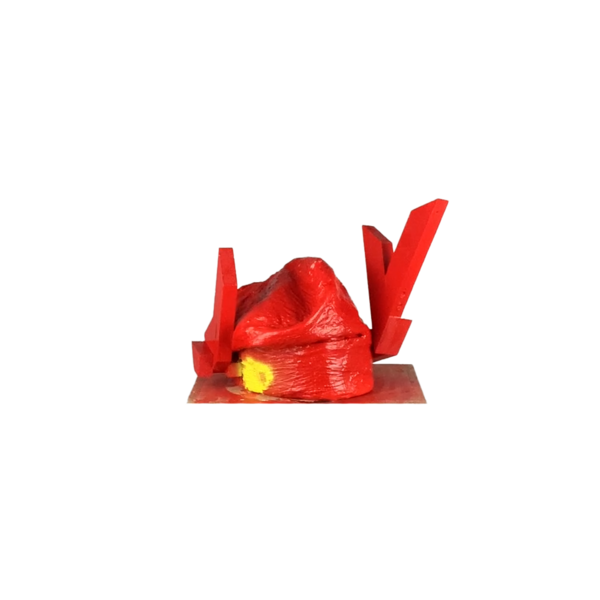 WITH MY BEING #4: (Ori Ade)
WITH MY BEING #4: (Ori Ade)WITH MY BEING #4: (Ori Ade), 2022
acrylic, spray paint, plaster, and pressure-treated lumber on fila
10” x 15”
This sculpture Ori Ade, investigates yoruba knowledge systems of belief and practice in relation to the concept of destiny: fate vs free will, divine predestination vs self pre-destination. In Yoruba, the ori is extremely integral to the idea of destiny as it represents the spiritual component of one's humanity and the physical head. It is believed that one chooses their head/ori upon creation- (akunleyan) but the ori is also a spiritual entity present during creation predestined and sealed (akunlegba and ayanmo) by the determiner of destiny- olodumare
"Ori Ade" translates to "head of crown" in English language, so this sculpture acts as a physical embodiment of my ori/head as well as my relationship with it. The Yoruba knowledge system regarding destiny is one that is complex, tethering fatalism and self-determinism depending on the situation or circumstance. This sculpture aims to exist in the space between- fate and destiny, acknowledging phenomenas beyond human control while strengthening the power of the freewill to shape our existence
Ori Ade features wooden-like ears that act as an antenna or communication device, connecting the metaphysical external world of fate and divine predestination, to the internal world of self-choice and freewill. Likewise, the physical ears are personified through the angular formations of the wood, embodying the appendages as a transformer- receiving stimulus from the environment to inform a response to our existence in a sort of lifetime feedback loop.
Usually appropriated through a lot of my paintings, this sculpture is dominated by the color Red, signifying a spiritual infinity of possibilities and abundance simply through existence. This work reflects a modern adaptation of the ori, echoing the sentiment that as long as we are alive, we always have an opportunity and will to drive and define our existence.
PERFORMANCE - AFROABSTRACTURE
ON PERFORMANCE AND MOVEMENT
My sounds are a ritual of connection- Ancestral rhythms of divine transformation and harmony. As I commune with rhythm, I am connected to endless possibilities, celebration, jubilation, and transformation.
When I emit sounds and vibrations, I connect with the music of the stars and the earth. Through repetition, I evoke the auditory with reverence to the divine existence of sound itself and connect with the sacred rhythm of the universe that pulsates through this reality. The frequencies I emit are joyful noises that elevate the spirit through sound. Infinite bliss.
Sound, movement, rhythm, and spoken word become my worship of my ancestors. Entropy becomes my strength, and my truth is potential. This potential is the change waiting to be realized through rituals honoring harmony as the sacred spirit of sound.
-
my body, the SEED: POLYCHRONIC TIME BASED CAPTURE
"only a fool is blinded by time to think that time only exists in the way we act upon it and with it: This is a recipe for spiritual and eternal confusion"
I often think, or rather remember, how my ancestors (me) remember time. yesterday, happening tomorrow happening today all at the same time. My grandfather once told me the past is always alive in the present- To know where you are going, you have to know where you are coming from he said. I come from a long lineage of hunters, warriors, and land stewards, a descendant of Ogun, the governor of all technologies. Our greatest technology is energy which is in constant flux and change. Time becomes the channel in which energy is revered, felt, and recorded in the annals of history. Time is the witness of all creation, the companion of all primordial beings and spirits, and the orchestrator of the divine ALL.
-
THE POWER OF CHOICE (1)- VILLAGER performance at the Peale Museum
-
THE POWER OF CHOICE (2)- VILLAGER performance at the Peale Museum
-
Pheonix in the Portal- Performance for ÀṢẸ: EMBODYING THE DIVINE
Pheonix in the Portal with Hope and Faith McCorkle, Bromo Seltzer Arts Tower, Baltimore, MD on October 10, 2024
This performance explored the cyclical nature of life and death concerning change and how we can come to embody change individually and personally. Through an assortment of instruments, djembe, sound bowl, gongs, and voice accompaniments, the performance serves as a ritual of reverence to the benevolent ancestors, calling back to African and specifically Yoruba Traditions of honor as well as presenting this spiritually potent offering to the public to take part in. Thinking about the focus of the exhibition, the performance invites the public to search, find, and embody the divine, instructing us to explore our inner and outer worlds and re-imagine ourselves as sacred beings, ordained with the power (ÀṢẸ) to manifest (pà àse) and redefine our existential conditions
-
SPIRITUAL GINGER (performance at Maryland Art Place)
SHORT FILMS
-
that's the BOMB
that's the BOMB
-
GUARDIAN- short film
“The road shall never swallow you. The river of your destiny will always overcome evil. May you understand your fate. Suffering will never destroy you but will make you stronger, success will never confuse your scatter your spirit but will make you fly higher into the good sunlight. Your life will always surprise you”
SCULPTURES AND INSTALLATIONS
BUSH BOY!
Growing up in Nigeria, family members would seldom call me “Bush Boy” because of the energetic and inquisitive nature of the world that I possessed. Autobiographical in nature, BUSH BOY! depicts the evolution and journey of a young child who once embraced the world with naivete to a now- strong-willed artist, living vehemently through their art.
This body of work is a cohesive arrangement of paintings, mixed media, and visual installations that signify my artistic rebirth in a very animalistic fashion. The expressions in this exhibition reflect my past experiences as they continue to shape my present and future. Paintings like omo grandma, zenith, and migration, echo all of my voices of self and capture the essence of that self-re-defining journey from a third-person perspective. BUSH BOY! also serves as a revelation product of the metamorphosis of gender and masculinity. Works like The Man in the Suit, Idahun Mi, and the On Guard photograph series address societal constructions and performativity of masculinity while revealing the vibrancy and fluidity embracing genderqueer-ness brings.
The ethos of my work is defined by what it means to be human, investigating humanity as a product of social conditions and all -isms. Reflected in paintings like life is matter, cows they’re domesticating us, and Kapital Kronies and others, BUSH BOY! relates my changes in philosophy and thought regarding life and consciousness, capitalism, work, and overconsumption to the viewer.
Much like a journey, BUSH BOY! is the product of a ritualistic rebirth and metamorphosis of SELF, inviting viewers to reflect and seek meaning in their humanity. Challenging the statement, “that’s just how it is” with a more human-centered question- “does it have to be that way?”, These works invite the viewer to re-examine and better their understanding of our shared human conditions.
-
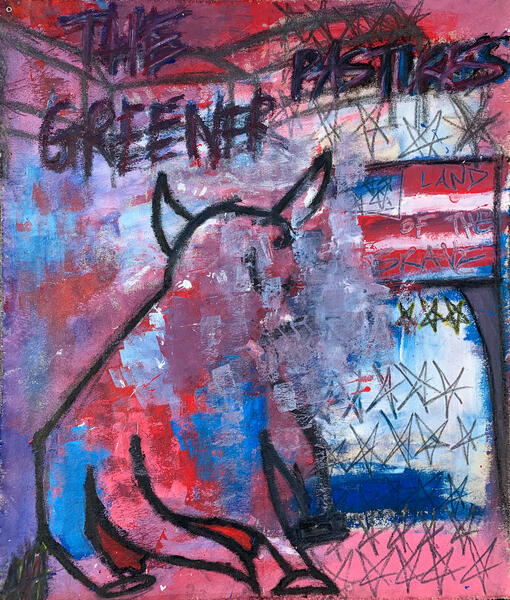 The American DreamAvailable for Purchase
The American DreamAvailable for Purchase -
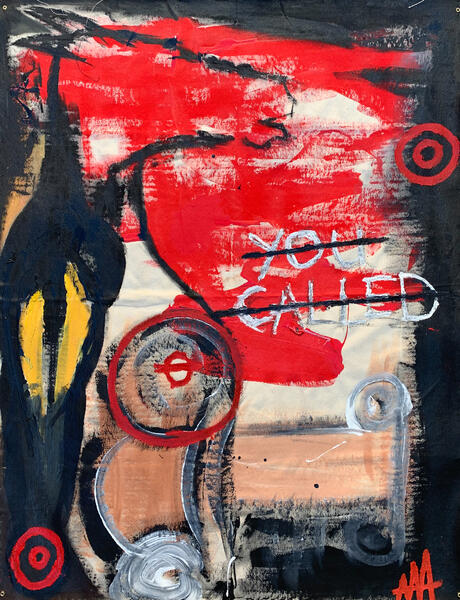 Idahun Mi
Idahun MiIdahun Mi, 2022
acrylic & oil on stretched canvas
48 x 36 in
-
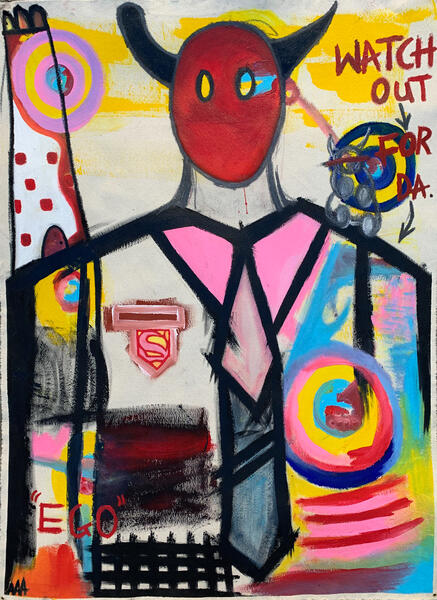 The Man in the Suit
The Man in the SuitThe Man in the Suit, 2022
acrylic, oil & oil pastel on stretched canvas
48 x 36 in
-
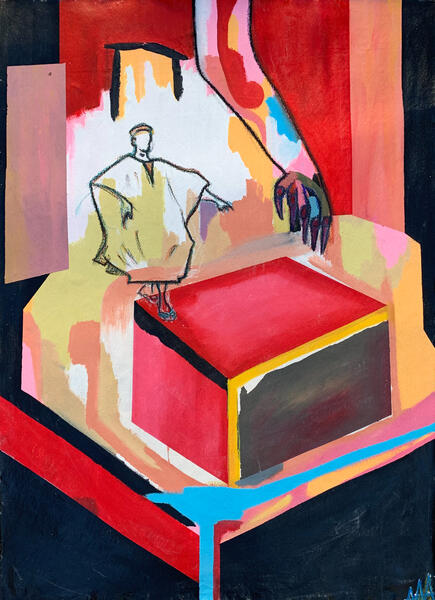 The great migration
The great migrationThe great migration, 2022
acrylic & oil pastel on stretched canvas
48 x 36 in
-
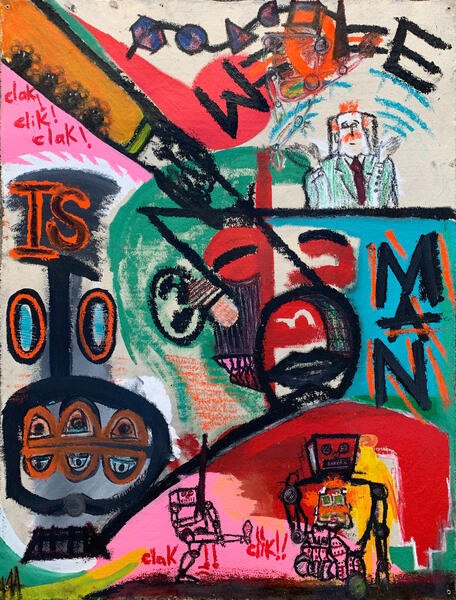 Kapital Kronies
Kapital Kronies -
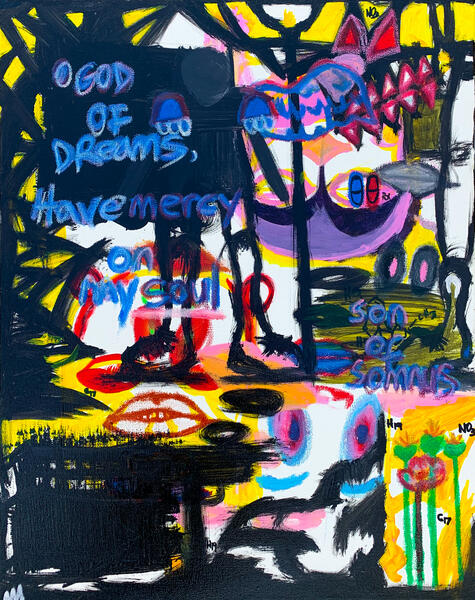 morpheus
morpheus
